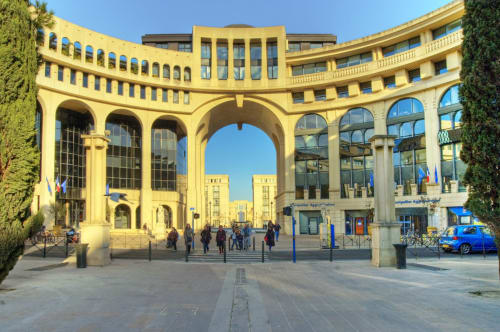THE ATYPICAL ANTIGONE DISTRICT, DESIGNED BY RICARDO BOFILL, COMBINES ANTIQUITY AND MODERNITY
A stone's throw from the 18th century mansions, behind the Polygone shopping centre, Montpellier continues its charm with Antigone, a district that has succeeded in bringing together residential space, office buildings, shops and culture in a harmonious way. As soon as you cross the monumental arch that marks the entrance to Antigone, you are seduced by the theatricality of the place: monumental proportions, colonnades, pediments and a perspective that runs all the way to the Lez.
Ricardo Bofill has imposed a neoclassical style that blends perfectly with the architecture of the city.
There are many references to Antiquity: rue de Thèbes, rue de l'Acropole, the squares of Sparta and Marathon, etc. The first square, called Place du Nombre d'Or (an allusion to the complex calculations that went into its design, with alternating round and square figures), is a haven of tranquillity, with unusual water features at its centre, spouting directly onto the ground. Then follow the Place du Millénaire, built in the image of a Roman circus with one of its sides rounded off, the Place de Thessalie with its amphitheatre-like appearance and its fountain with ephebes, the gigantic media library facing the Olympic swimming pool, the Esplanade de l'Europe and its majestic buildings facing the Lez and the Hôtel de Région, an imposing triumphal arch. Between it and the Place du Nombre d'Or, 1,800 m (just like the Champs-Elysées in Paris) of a surprising and impressive promenade, a bold link between the Montpellier of yesterday and that of tomorrow.
The Mas de Lafeuillade, a stone's throw from the banks of the Lez, allows you to reach the Antigone district in less than 15 minutes on foot.


